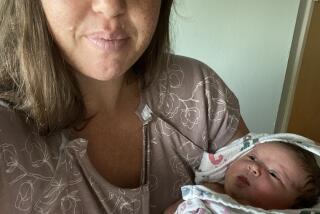Illness Returns 3 Sisters to Mental Infancy
- Share via
GREENACRES CITY, Fla. — Victoria Horton wears diapers, cannot feed herself and has the mind of a 6-month-old.
She is 9.
A cruel tumble of the genetic dice doomed Victoria and her sisters, Christina and Annie, to a short life because of Sanfilippo’s syndrome, a rare terminal illness that will return them to a state resembling infancy.
“They will lose all mental powers and become vegetative,” said the girls’ mother, Sheryl Horton.
On a hot October afternoon, the girls played in the living room of their white concrete house. Victoria gaped vacantly. Because of a misshapen spine, her head droops to the right. She moves about with her arms, dragging herself across a brown shag carpet.
“Victoria used to be able to talk. She used to be able to walk and run,” said Horton, who is divorced.
Never Spoke
Christina is 6 years old chronologically and 10 months old mentally. Full of the early symptoms of hyperactivity, she walks nonstop around the room, stumbles frequently, hums. She has never spoken or understood a word.
Annie, 4, is mother’s little helper. She disciplines her older sisters and is the best talker. She points to her eldest sister and says, “Toria.” She bounces on the couch as if it were a trampoline.
Annie “tries to help. She tries to change her diapers,” Horton said. “She tells Christina, ‘No.’ She’ll say, ‘Christina, no,’ and she may even slap her.”
Horton said Annie now seems to have memory lapses--another symptom of the disease.
Horton gave birth to Victoria in September, 1977, just months after graduating in the top 15% of her class at John I. Leonard High School in Lake Worth, Fla.
Four Operations
Victoria was sickly and underwent surgery four times in four years. Doctors did not diagnose Sanfilippo’s syndrome right away, and the Hortons had two more children.
The disease is a product of two abnormal genes--one from each parent--uniting at conception. The odds of bearing a child with the illness are one in 100,000, said Dr. Joseph Muenzer, a pediatrics researcher at the University of Michigan.
Victims lack the enzyme necessary to stem the spread of mucopolysaccharides, carbohydrate-like substances that destroy brain cells.
Muenzer said there are usually no telltale signs of the illness at birth. Abnormalities such as slow speech appear between ages 2 and 4. The brain ceases to develop and deterioration begins between ages 5 and 7.
“They actually lose skills they once had,” he said. “They return to a primitive development.”
Usually Die in Teens
Most victims die--often of heart and respiratory difficulties--in their teens, Muenzer said. Only a few survive to their 20s and 30s.
“You can just look at Victoria and tell she’s not going to make it to her 20s,” her mother said.
Beyond age 10, those afflicted with Sanfilippo’s are severely retarded and infirm--young in mind, old in body.
“That’s the dichotomy. They no longer read, think and all, but the body ages,” Muenzer said.
Early last year, doctors confirmed that the girls suffered from the syndrome. The news left Horton numb. Today, she is philosophical.
“We’re all terminal,” she said. “Some of us are more terminal than others.”
Horton, 27, studies chemistry at Palm Beach Junior College and maintains a B+ average. She is unsure about what direction her career will take.
Victoria and Christina attend a school for the handicapped. Annie goes to preschool.
The family lives on $1,000 a month in Supplemental Security Income--drawn against future Social Security benefits. Horton also tutors in algebra but has found that a full-time job would pay little more than the baby sitter.
Scholarships and grants cover Horton’s tuition and school expenses. She receives Medicaid payments and free medical care for the girls. The Shriners, a public service group, is offering to buy a $2,000 wheelchair for Victoria.
More to Read
Sign up for Essential California
The most important California stories and recommendations in your inbox every morning.
You may occasionally receive promotional content from the Los Angeles Times.













